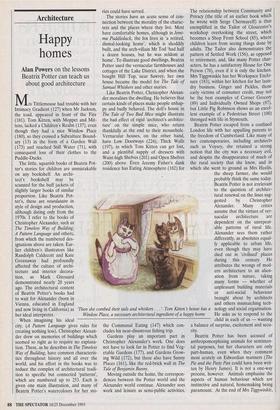Architecture
Happy homes
Alan Powers on the lessons Beatrix Potter can teach us about good architecture Mrs Tittlemouse had trouble with her Intimacy Gradient (127) when Mr Jackson, the toad, appeared in front of the Fire (181). Tom Kitten, with Moppet and Mit- tens, lacked a Children's Realm (137), even though they had a nice Window Place (180), so they crossed a Subculture Bound- ary (13) in the form of a Garden Wall (173) and reached Still Water (71), with consequent loss of their clothes to the Puddle-Ducks.
The little, squarish books of Beatrix Pot- ter's stories for children are unmistakable on any bookshelf. An archi- tect's bookshelf may be scanned for the buff jackets of slightly larger books of similar proportion. Like Beatrix Pot- ter's, these are retardataire in style of design and production, although dating only from the 1970s. I refer to the books of Christopher Alexander, such as The Timeless Way of Building, A Pattern Language and others, from which the numbered des- ignations above are taken. Ear- lier children's illustrators like Randolph Caldecott and Kate Greenaway had profoundly affected the culture of archi- tecture and interior decora- tion, as Mark Girouard demonstrated nearly 20 years ago. The architectural content of Beatrix Potter's books had to wait for Alexander (born in Vienna, educated in England and now living in California) as her ideal interpreter.
When imagining his ideal city, (A Pattern Language gives rules for creating nothing less), Christopher Alexan- der drew on memories of buildings which seemed so right as to require no explana- tion. These, as he describes in The Timeless Way of Building, have common characteris- tics throughout history and all over the world, and his effort in the books was to reduce the complex of architectural tradi- tion to specific but connected `patterns', which are numbered up to 253. Each is given one main illustration, and many of Beatrix Potter's watercolours for her sto- ries could have served.
The stories have an acute sense of con- nection between the morality of the charac- ters and the places where they live. Most have comfortable homes, although in Joni- ma Puddleduck, the fox lives in `a retired, dismal-looking home', which is shoddily built, and the arch-villain Mr Tod 'had half a dozen houses, but he was seldom at home'. To illustrate good dwellings, Beatrix Potter used the vernacular farmhouses and cottages of the Lake District, and when she bought Hill Top, near Sawrey, her own house became the model for The Tale of Samuel Whiskers and other stories.
Like Beatrix Potter, Christopher Alexan- der moralises the dwelling. He believes that certain kinds of places make people unhap- py and badly behaved. The doll's house in The Tale of Two Bad Mice might illustrate the bad effect of rigid `architect's architec- ture' on the simple mice, who return thankfully at the end to their mousehole. Vernacular houses, on the other hand, have Low Doorways (224), Thick Walls (197), in which Tom Kitten can get lost, and a plentiful supply of dressers with Waist-high Shelves (201) and Open Shelves (200) above. Even Jeremy Fisher's dank residence has Eating Atmosphere (182) for
`Then she combed their tails and whiskers . . Tom Kitten's Window Place, a necessary architectural ingredient of a ha the Communal Eating (147) which con- cludes his near-disastrous fishing trip.
Gardens play an important part in Christopher Alexander's work. One does not have to look far in Potter to find Veg- etable Gardens (177), and Gardens Grow- ing Wild (172), but these also have Sunny Places (161), like the red-brick wall in The Tale of Benjamin Bunny.
Moving outside the home, the correspon- dences between the Potter world and the Alexander world continue. Alexander sees work and leisure as semi-public activities. The relationship between Community and Privacy (the title of an earlier book which he wrote with Serge Chermayeff) is thus exemplified in the Tailor of Gloucester's workshop overlooking the street, which becomes a Shop Front School (85), where children learn from seeing things done by adults. The Tailor also demonstrates the pattern of Settled Work (156), as opposed to retirement, and, like many Potter char- acters, he has a satisfactory House for One Person (78), even if it is only the kitchen. Mrs Tiggywinlde has her Workspace Enclo- sure (183), within her kitchen for her laun- dry business. Ginger and Pickles, those early victims of consumer credit, may not be the best examples of Corner Grocery (89) and Individually Owned Shops (87), but Little Pig Robinson shows us an excel- lent example of a Pedestrian Street (100) thronged with life in Stymouth.
Beatrix Potter escaped from a confined London life with her appalling parents to the freedom of Cumberland. Like many of her contemporaries, including architects such as Voysey, she retained a strong notion that the city was a necessary evil, and despite the disappearance of much of the rural society that she knew, and in which she went to ground as Mrs Heelis, the sheep farmer, she would probably think the same today. Beatrix Potter is not irrelevant to the question of architec- tural renewal on the lines sug- gested by Christopher Alexander. Many critics assume that the virtues of ver- nacular architecture are dependent on the unrepeat- able patterns of rural life. Alexander sees them rather differently, as absolutes equal- ly applicable to urban life, even though they may have died out in 'civilised' places during this century. He attributes the wrongs of mod- ern architecture to an alien- ation from nature, taking many forms — whether of unpleasant building materials or anti-social behaviour brought about by architects and others mismatching tech- house has a nology and social organisation.
ppy home He asks us to respond to the child in each of us — wanting a balance of surprise, excitement and secu- rity.
Beatrix Potter has been accused of anthropomorphising animals for sentimen- tal purposes, but her characters are only part-human, even when they comment most acutely on Edwardian manners (The Pie and the Patty Pan could have been writ- ten by Henry James). It is not a one-way process, however. Animals emphasise the aspects of human behaviour which are instinctive and natural, homemaking being paramount. At the end of Mrs Tiggywinkle,
the washerwoman becomes a hedgehog in the eyes of the child, Lucy, as if to remind us that man's acceptance by the natural world comes only by a hard-won innocence.











































































































 Previous page
Previous page